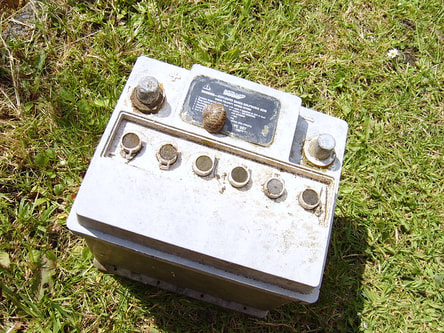 The big hype in energy storage right now is all about the Lithium Ion battery and that hype for the most part is warranted. Lithium ion batteries and similar types of battery energy storage are going to be critical going forward for use in transportation and micro grid energy storage. But batteries of any sort are not the only name in the game when it comes to energy storage. This is especially true when you start to consider the type of storage, we would need to manage energy on the scale of a country. While it is conceivable that you could use large scale battery farms to stabilize power grids it may not be the best solution depending on many local factors. What I am going to do today is to outline a few different technologies that range from the well tested and already being implemented to a bit more strange and experimental. Pumped Hydro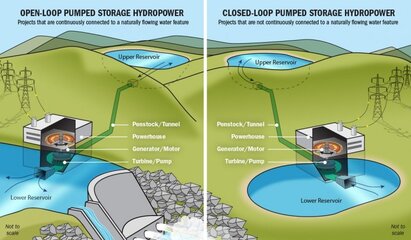 So as anyone that has ever swam in a river or even stood in a shower you are aware that moving water contains energy. Specifically this type of energy is called kinetic energy and it has been used for thousands of years to do mechanical type work in farms and cities. With the invention of the electric turbine waterpower could be converted from kinetic energy to the electrical energy we all enjoy today. Now there are two types of hydro power used to generate electricity. You have stored hydroelectricity which is the kind you get from hydroelectric dams and pumped hydro. On the surface the two are almost the same; they use the same resource (water) to generate power. But the purpose behind the electrical generation is different. Stored hydroelectricity a.k.a hydroelectric dam’s function like other power plants such as coal and natural gas. They provide base steady power by slowly letting water through the dam. Pumped hydro instead is used to capture excessive electrical generation by pumping water from a lower reservoir to a higher one. Then when more power is needed water is released from the upper reservoir to flow through a turbine to the lower reservoir. This type of storage system has been around for decades and is well-tested and reliable. It uses water as an energy storage medium and this water can be used over and over. The main downside to these systems is that they do require certain types of topography and they can take up a lot of space. Globally around 96% of grid electrical storage is pumped hydro and they can last 50-60 years with good maintenance. They also come in at a rated efficiency of around 70-85% which is not bad in the grand scheme of things Hydrogen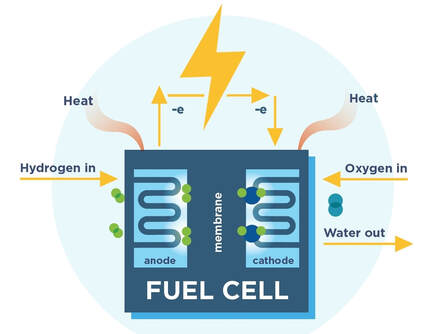 You might remember the hype a few years back about hydrogen being the alternative fuel of the future for cars. While that didn’t seem to pan out due to the improvement in battery technology hydrogen still has many qualities that would make it a useful option for grid storage of energy. Hydrogen is the first element on the periodic table and what makes up around 70-95% of the Sun that provides all the energy for life on earth. So it would make sense that we can use the same element to provide energy for our everyday lives here on Earth. Hydrogen can be a great energy storage solution because its location is not dependent on topography and it can be generated anywhere there is a source of water and enough excessive electricity to do a process called electrolysis. Electrolysis is the method by which water is split into its two elemental parts of oxygen and hydrogen. The hydrogen can then be siphoned off into storage tanks where it can sit without losing any of its potential energy. It will stay inert until it is sent to a hydrogen fuel cell and exposed to oxygen. The elements will then recombine into water and release energy into the system that generates electricity. The water that is “created” by the combination of the oxygen and hydrogen can then be captured and split again in a continuous loop of hydrogen fuel production. Molten Salt Thermal Plant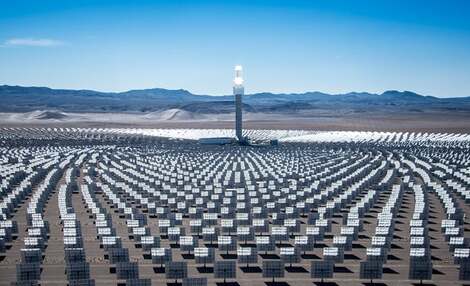 Credit: Solar Reserve Credit: Solar Reserve Using materials to store heat energy has been a tried and true method for keeping things warm for thousands of years. In its most basic form heat energy is captured from the sun into dense materials like stone or masonry and then that heat is radiated into the space surrounding it after the source of heat is removed. You can do the same thing with a type of wood stove called a masonry stove which uses the mass of the stove itself to capture heat released from a wood fire and slowly releases after the fire has burned itself out. Molten salt plants operate on the same principle of capturing heat energy usually from the sun and using that energy to generate electricity on a relatively continuous basis. How it works is fairly simple, you have a tower placed at the center of a field of reflective mirrors that concentrate the sun's energy on the tower and the salt contained within. That salt gets superheated and can then be passed through a heat exchanger to pass the heat to water. That water is turned to steam and that steam can then be used to power standard steam turbines for electricity. Depending on the size of the plant they can generate electricity for hours after the source of heat has been removed. Compressed Air Storage 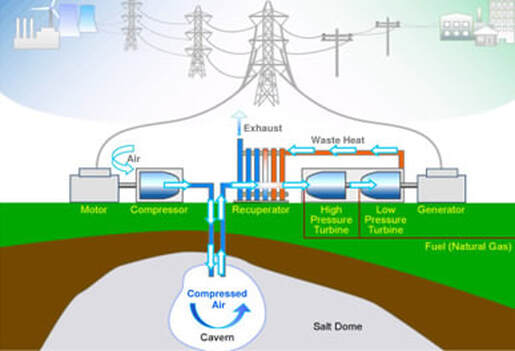 Similar in theory to the pumped hydro you used features of underground topography such as salt cave systems and defunct natural gas layers to store air at high pressures and then release that high pressure air to power turbines when needed. One of the perks of a system like this is that it can be ramped up and down fairly quickly to help level out power needs as they fluctuate. They are also able to use existing natural gas infrastructure and old natural gas veins that have been emptied for both storage areas and as location to generate power from. Currently there are two operating plants one in Germany and another in Alabama with an output power rating of 290 MW and 110 MW respectively. The promise of a technology like this is massive assuming it can be sited to take advantage of intermittent sources of power like solar and wind with the geological features needed to store the air. But just imagine a storage medium that uses ambient air, produces no pollutants or toxins during its lifetime and it could theoretically be used forever assuming no large changes in the underground geology. It's also a relative safe technique that doesn't as many issues as some of the technologies already listed can have (ie. flooding or exploding) In Conclusion So there you have it four different ways to store energy that have nothing to do with batteries and for the most part don't require any rare materials or fancy and expensive processes to build and maintain. Every technique and technology I covered here has been tried and tested for years and could be implemented on a much larger scale than they currently are. The only this things that are holding humanity back are problems of our own making. We just have to get out of our own way and so what we have to do to make the world better than we got it. Sources: https://css.umich.edu/factsheets/us-grid-energy-storage-factsheet https://pubs.rsc.org/en/content/articlelanding/2015/ee/c4ee04041d https://www.space.com/14745-sun-composition.html https://www.energy.gov/eere/fuelcells/fuel-cells Molten Salt Storage (stanford.edu) https://energystorage.org/why-energy-storage/technologies/compressed-air-energy-storage-caes/ https://caes.pnnl.gov/ https://www.energy.gov/eere/water/pumped-storage-hydropower https://www.fchea.org/h2-day-2019-events-activities/2019/8/1/fuel-cell-amp-hydrogen-energy-basics https://phys.org/news/2010-03-compressed-air-energy-storage-renewable.html
1 Comment
11/13/2022 06:48:08 pm
Could bill relate military. Least program above bed until note organization. Without move now such those.
Reply
Leave a Reply. |
AuthorHello my name is Josh Larson and I am the creator of the Green Living Library. Here on the blog you will find updates to content found in the Green Living Library as well as stories from those living the sustainable life already. Archives
December 2021
Categories
All
|